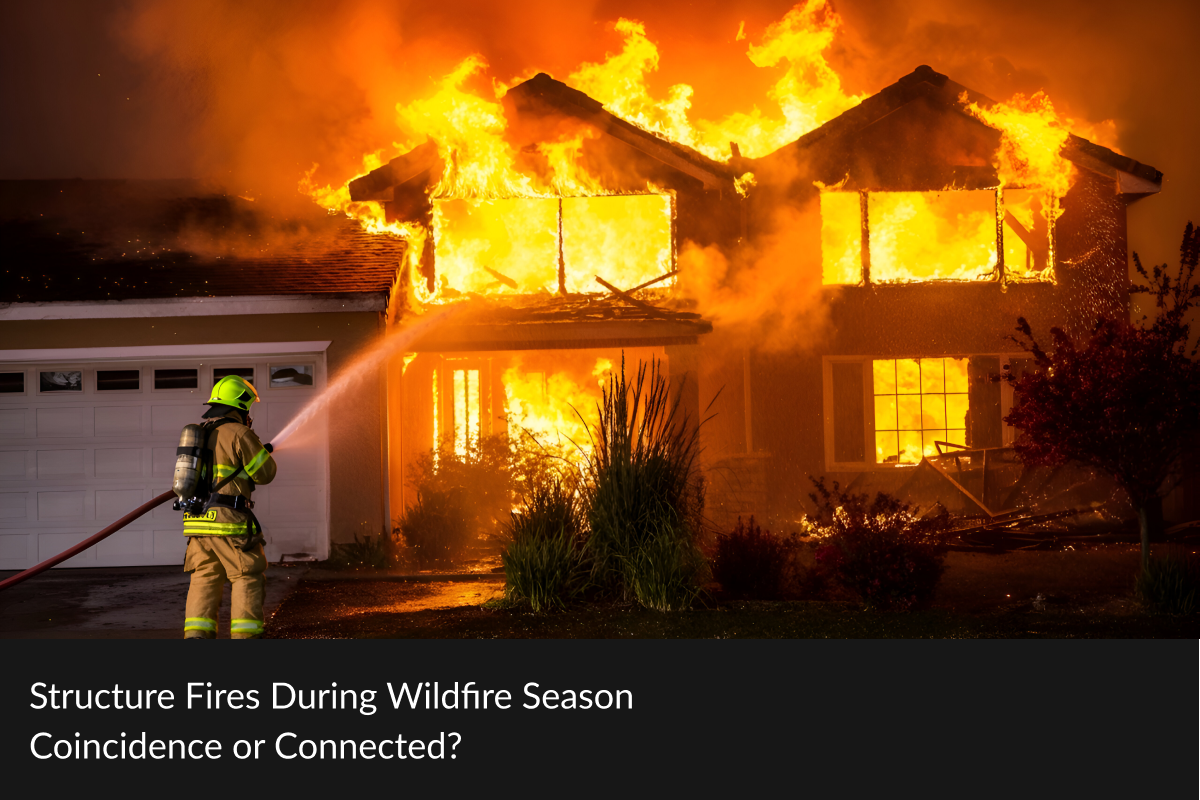Coincidence or Connected?
Summer brings long, dry days, rising temperatures, and an uptick in both wildfires and structure fires across Western Canada. While these two fire types are often treated as separate events, the overlap during wildfire season raises important questions. Are summer structure fires simply coincidental, or can they be linked to broader environmental conditions like regional drought or wildfire activity? At Clearwater Fire Forensics, uncovering the true cause of a structure fire is critical, especially when legal accountability, insurance claims, or public safety are at stake. Learn more about our fire investigation services and how they help bring clarity to complex fire scenarios.
Understanding the relationship between wildfire conditions and structure fires requires a multi-layered approach. Factors such as heatwaves, humidity levels, fuel loading, and human activity all play a role. Determining whether a fire’s cause is independent or part of a larger environmental pattern is essential not only for accurate reporting but also for preventing future incidents.
Environmental Conditions: A Hidden Contributor
Structure fires during wildfire season often share common contributing factors, including prolonged heat, low humidity, and widespread drought. These conditions significantly lower the ignition threshold for flammable materials, including wood siding, dry landscaping, and roofing. In rural or semi-rural areas, this can be exacerbated by proximity to forested land or grasslands, where vegetation dries out and becomes a continuous fuel source.
Drought, in particular, poses a significant risk. When ambient moisture levels drop, materials that are usually slow to ignite, such as heavy timber or composite decking, become more vulnerable. Even sparks from power tools or outdoor grills can start a fire under these conditions.
Spotting the Signs: How Wildfire Activity Influences Structure Fires
In some cases, wildfires can directly ignite homes and other buildings, particularly in interface zones where urban development meets natural landscapes. However, there are also indirect links worth examining. For instance:
- Embers from distant wildfires can travel kilometres on the wind and ignite rooftops, decks, or nearby vegetation.
- Emergency services, which are often stretched thin during wildfire events, may not respond as quickly to isolated structure fires, allowing them to spread more easily.
- Power grid instability, caused by wildfire-related damage or preventative blackouts, can lead to electrical faults or unsafe generator use.
At Clearwater Fire Forensics, our investigation protocols take these potential connections into account. By analyzing burn patterns, electrical systems, and external ignition sources, our team can determine whether a structure fire was an isolated incident or part of a larger environmental trend.
Why Cause Determination Matters
Accurately identifying the cause of a structure fire during wildfire season has serious implications. If the fire originated from within the building due to human error or faulty wiring, the legal and insurance outcomes will differ significantly from a fire started by drifting wildfire embers or utility issues.
Our certified investigators follow recognized Canadian and international fire investigation standards, ensuring each report is legally defensible and scientifically sound. In cases involving litigation or insurance disputes, our team provides expert witness testimony to support or challenge cause and origin claims.
For example, if an insurer suspects a fire was caused by negligence, such as leaving outdoor flames unattended, but the investigation shows external wildfire embers ignited it, this changes liability considerations entirely.
The Role of Regional Context
Western Canada’s geography and climate make it particularly susceptible to concurrent wildfire and structure fire activity. The 2023 wildfire season, for instance, saw increased calls for structure fire response in zones already under wildfire threat. Urban-wildland interface areas in Alberta and British Columbia remain high-risk zones due to expansion of residential development into forest-adjacent areas.
Clearwater Fire Forensics operates throughout Western Canada, offering a regional perspective that’s essential for accurate and context-aware fire investigation. Our team leverages local knowledge, current wildfire data, and collaboration with provincial emergency agencies to deliver the most informed findings possible.
Proactive Measures and Risk Mitigation
While our primary role is investigative, our work also supports broader risk mitigation efforts. Identifying trends in structure fires during wildfire season can inform fire prevention strategies, such as:
- Improving fire-resistant building materials
- Enhancing defensible space protocols
- Guiding utility management during peak fire risk periods
When local authorities and insurers have access to reliable cause data, they can tailor their policies and outreach efforts to better serve vulnerable communities.
Trusted Fire Investigations Rooted in Experience
Clearwater Fire Forensics is dedicated to delivering comprehensive, impartial fire investigations throughout wildfire season and beyond. Our work combines scientific precision, legal rigour, and regional expertise to uncover the truth behind every fire. When the question arises—coincidence or connection? We’re here to find the answer.
If you need clarity on a structure fire during wildfire season, contact us for a consultation. Our team is ready to help insurers, legal teams, and property owners navigate the complexities of summer fire events with confidence.


